The Intel Ivy Bridge (Core i7 3770K) Review
by Anand Lal Shimpi & Ryan Smith on April 23, 2012 12:03 PM EST- Posted in
- CPUs
- Intel
- Ivy Bridge
The Test
It turns out that our initial preview numbers were quite good. The shipping 3770K performs identically to what we tested last month. To keep the review length manageable we're presenting a subset of our results here. For all benchmark results and even more comparisons be sure to use our performance comparison tool: Bench.
| Motherboard: | ASUS P8Z68-V Pro (Intel Z68) ASUS Crosshair V Formula (AMD 990FX) Intel DX79SI (Intel X79) Intel DZ77GA-70K (Intel Z77) |
| Hard Disk: | Intel X25-M SSD (80GB) Crucial RealSSD C300 OCZ Agility 3 (240GB) |
| Memory: | 4 x 4GB G.Skill Ripjaws X DDR3-1600 9-9-9-20 |
| Video Card: | ATI Radeon HD 5870 (Windows 7) AMD Processor Graphics Intel Processor Graphics |
| Video Drivers: | AMD Catalyst 12.3 |
| Desktop Resolution: | 1920 x 1200 |
| OS: | Windows 7 x64 |
General Performance
SYSMark 2007 & 2012
Although not the best indication of overall system performance, the SYSMark suites do give us a good idea of lighter workloads than we're used to testing. SYSMark 2007 is a better indication of low thread count performance, although 2012 isn't tremendously better in that regard.
As the SYSMark suites aren't particularly thread heavy, there's little advantage to the 6-core Sandy Bridge E CPUs. The 3770K however manages to slot in above all of the other Sandy Bridge parts at between 5—20% faster than the 2600K. The biggest advantages show up in either the lightly threaded tests or in the FP heavy benchmarks. Given what we know about Ivy's enhancements, this is exactly what we'd expect.
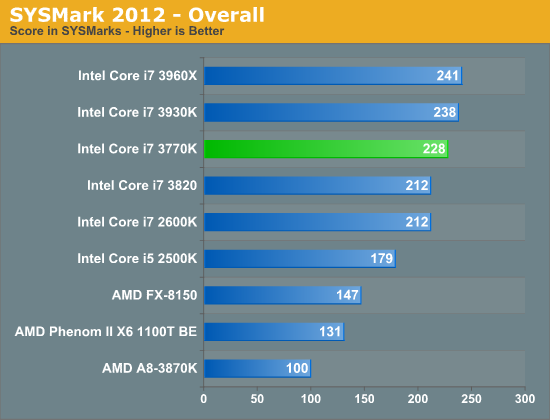
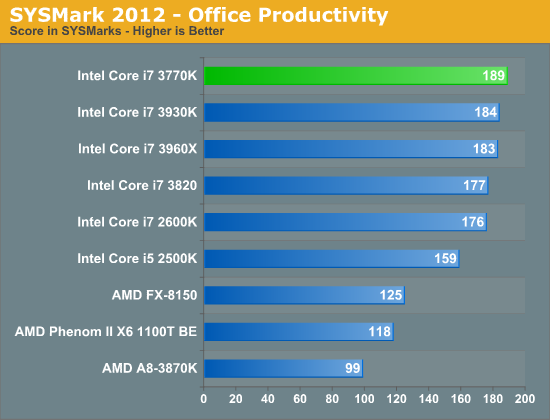

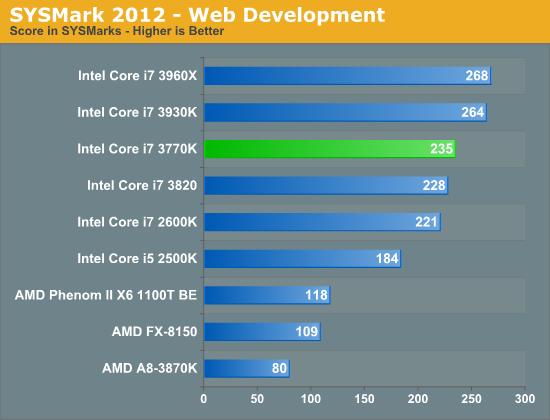
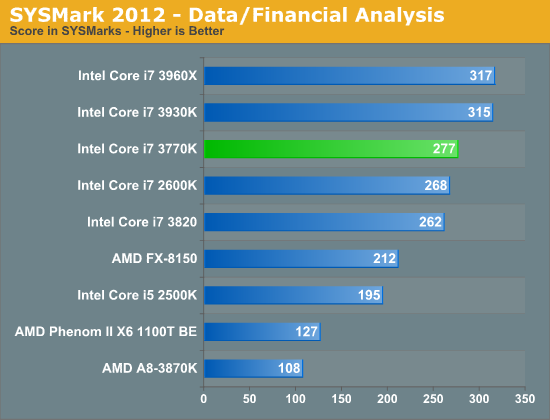
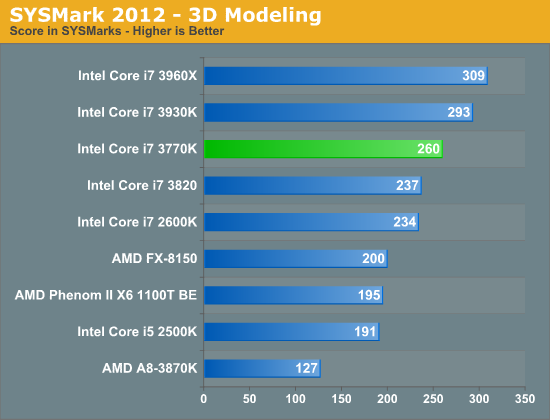


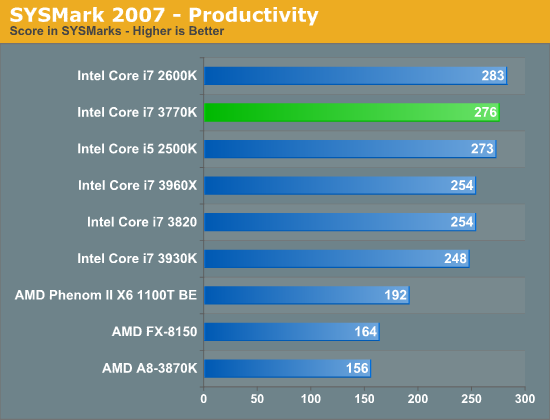
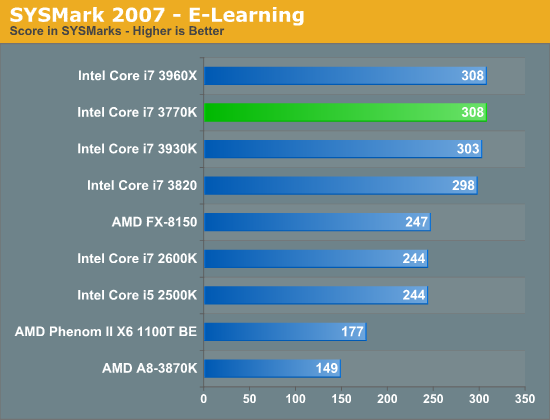
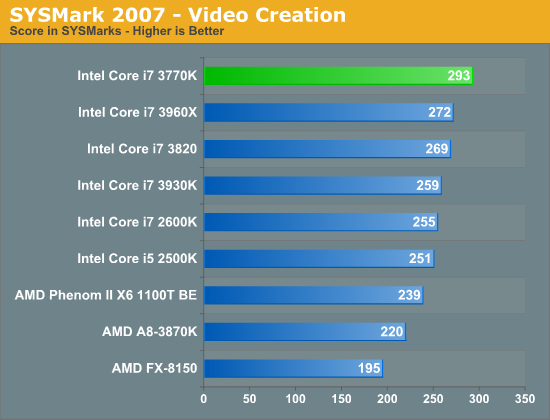

Content Creation Performance
Adobe Photoshop CS4
To measure performance under Photoshop CS4 we turn to the Retouch Artists’ Speed Test. The test does basic photo editing; there are a couple of color space conversions, many layer creations, color curve adjustment, image and canvas size adjustment, unsharp mask, and finally a gaussian blur performed on the entire image.
The whole process is timed and thanks to the use of Intel's X25-M SSD as our test bed hard drive, performance is far more predictable than back when we used to test on mechanical disks.
Time is reported in seconds and the lower numbers mean better performance. The test is multithreaded and can hit all four cores in a quad-core machine.
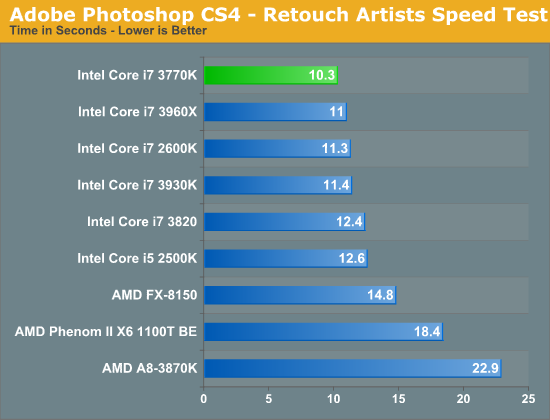
Our Photoshop test is well threaded but it doesn't peg all cores constantly. Instead you get burstier behavior. With the core count advantage out of the way, SNB-E steps aside and allows the 3770K to step up as the fastest CPU we've tested here. The performance advantage over the 2600K is around 9%.
3dsmax 9
Today's desktop processors are more than fast enough to do professional level 3D rendering at home. To look at performance under 3dsmax we ran the SPECapc 3dsmax 8 benchmark (only the CPU rendering tests) under 3dsmax 9 SP1. The results reported are the rendering composite scores.
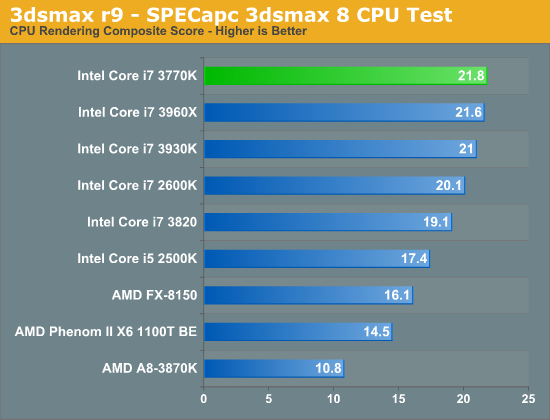
In another FP heavy workload we see a pretty reasonable gain for Ivy Bridge: 8.5% over a 2600K. This isn't enough to make you want to abandon your Sandy Bridge, but it's a good step forward for a tick.
Cinebench 11.5
Created by the Cinema 4D folks we have Cinebench, a popular 3D rendering benchmark that gives us both single and multi-threaded 3D rendering results.
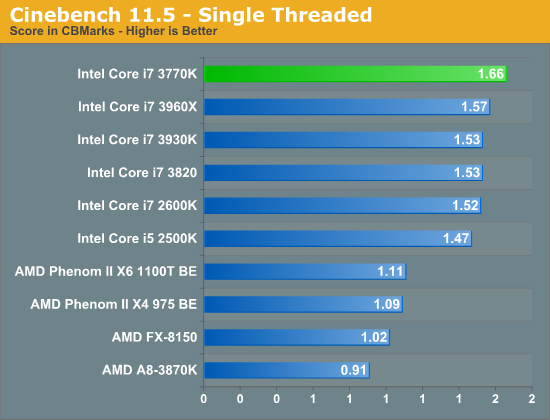
The single threaded Cinebench test shows a 9% performance advantage for the 3770K over the 2600K. The gap increases slightly to 11% as we look at the multithreaded results:
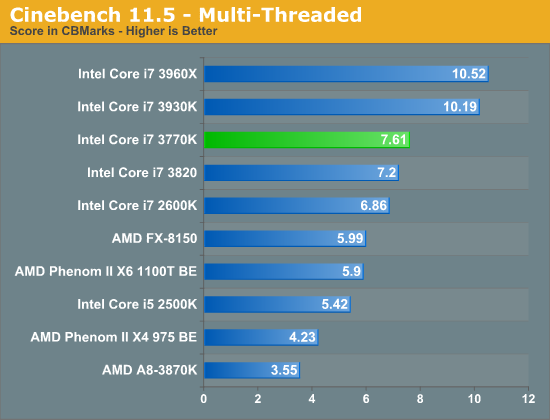
If you're running a workload that can really stress multiple cores, the 6-core Sandy Bridge E parts will remain unstoppable but in the quad-core world, Ivy Bridge leads the pack.
Video Transcoding Performance
x264 HD 3.03 Benchmark
Graysky's x264 HD test uses x264 to encode a 4Mbps 720p MPEG-2 source. The focus here is on quality rather than speed, thus the benchmark uses a 2-pass encode and reports the average frame rate in each pass.

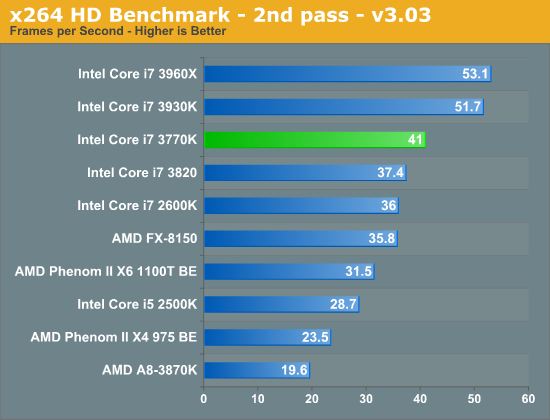
In the second pass of our x264 test we see a nearly 14% increase over the 2600K. Once again, there's no replacement for more cores in these types of workloads but delivering better performance in a lower TDP than last year's quad-core is great for more thermally conscious desktops.
Software Development Performance
Compile Chromium Test
You guys asked for it and finally I have something I feel is a good software build test. Using Visual Studio 2008 I'm compiling Chromium. It's a pretty huge project that takes over forty minutes to compile from the command line on a Core i3 2100. But the results are repeatable and the compile process will stress all 12 threads at 100% for almost the entire time on a 980X so it works for me.
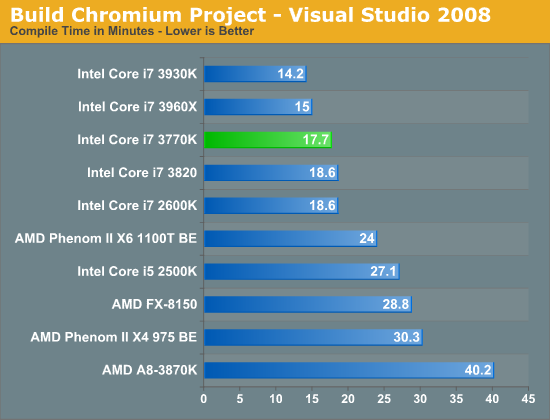
Ivy Bridge shows more traditional gains in our VS2008 benchmark—performance moves forward here by a few percent, but nothing significant. We are seeing a bit of a compressed dynamic range here for this particular compiler workload, it's quite possible that other bottlenecks are beginning to creep in as we get even faster microarchitectures.
Compression & Encryption Performance
7-Zip Benchmark
By working with a small dataset, the 7-zip benchmark gives us an indication of multithreaded integer performance without being IO limited:
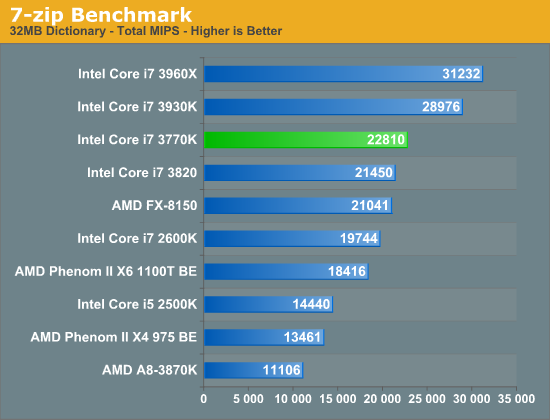
Although real world compression/decompression tests can be heavily influenced by disk IO, the CPU does play a significant role. Here we're showing a 15% increase in performance over the 2600K. In the real world you'd see something much smaller as workloads aren't always so well threaded. The results here do have implications for other heavily compute bound integer workloads however.
TrueCrypt Benchmark
TrueCrypt is a very popular encryption package that offers full AES-NI support. The application also features a built-in encryption benchmark that we can use to measure CPU performance:

Our TrueCrypt test scales fairly well with clock speed, I suspect what we're seeing here might be due in part to Ivy's ability to maintain higher multi-core turbo frequencies despite having similar max turbo frequencies to Sandy Bridge.










173 Comments
View All Comments
JarredWalton - Tuesday, April 24, 2012 - link
I don't think it's a mystery. It's straight fact: "One problem Intel does currently struggle with is game developers specifically targeting Intel graphics and treating the GPU as a lower class citizen."It IS a problem, and it's one INTEL has to deal with. They need more advocates with game developers, they need to make better drivers, and they need to make faster hardware. We know exactly why this has happened: Intel IGP failed to run for so long that a lot of developers gave up and just blacklisted Intel. Now, Intel is actually capable of running most games, and so long as they aren't explicitly blacklisted things should be okay.
In truth, the only title I can think of from recent history where Intel could theoretically work but was blacklisted by the game developer is Fallout 3. Even today, if you want to run FO3 on Intel IGP (HD 2000/3000/4000), you need to download a hacked DLL that will identify your Intel GPU as an NVIDIA GT 9800 or something.
And really, there's no need to blacklist by game developers, because you can't predict the future. FO3 is the perfect example: it runs okay on HD 3000 and plenty fast on HD 4000, but the shortsighted developers locked out Intel for all time. It's better to pop up a warning like some games do: "Warning: we don't recognize your driver and the game may not run properly." Blacklisting is almost more of a political statement IMO.
craziplaya21 - Monday, April 23, 2012 - link
I might be blind or something but did you guys not do a comparison between an original bluray IQ vs an encoded 1080p IQ by quicksync??toyotabedzrock - Monday, April 23, 2012 - link
Why is Intel disabling this on the K parts? And why disable vPro?jwcalla - Monday, April 23, 2012 - link
First, a diversion: "I was able to transcode a complete 130 minute 1080p video to an iPad friendly format..." Just kill me. Somebody please. Why do consumers put up with this crap? Even my ancient Galaxy S has better media playback support.It's the same story with my HP TouchPad: MP4 container or GTFO. Who can stand to re-encode their media libraries or has the patience to deal with DLNA slingers when the hardware is perfectly capable of curb-stomping any container / codec you could even conceive? Just get an Android tablet if this is the crap they force on you. Or, in the TouchPad case, wipe it and install ICS.
As for the article... did I totally misunderstand the page about power consumption? I got the impression that idle power is relatively unchanged. I must be misreading that. Or maybe the lower-end chips will show a stark improvement. Otherwise I totally miss the point of IVB.
I'm beginning to lose confidence in Intel, at least in terms of innovation. These tick-tock improvements are basically minor pushes in the same boring direction. From an enthusiasts' perspective, the stuff going into ARM SoCs is so much more interesting. Intel makes great high-end CPUs but it seems that these are becoming less important when looking at the consumer market as a whole.
Anand Lal Shimpi - Monday, April 23, 2012 - link
Idle power didn't really go down because at idle nearly everything is power gated to begin with. Any improvements in leakage current don't help if the transistors aren't leaking to begin with :)Your ARM sentiments are spot on for a huge portion of the market however. Let's see what Haswell brings...
Take care,
Anand
thomas-hrb - Monday, April 23, 2012 - link
I disagree with the testing methodology for the World of Warcraft test. Firstly no gamer of any game buys hardware so they can go to the most isolated areas in a game. Also the percentage of who can pay for one of these CPU's who would be playing at 1650x1050, would be pretty small.I've been playing WoW for a number of years and I don't care about 60fps+ because my monitor won't display it anyway. I care about minimum fps and average fps. nVidia's new adaptive vsync is a great innovation, but I am sure there are other tests that while not as controlled and repeatable is a much indicative of real world performance (the actual reason behind purchasing decisions).
One possible testing methodology you could look into is to take a character into one of the topend 25man raids. There are 10 classes in WoW and my experience is that a 25man raid will show up every single possible spell/ability and effect that the game has to offer in fairly repeatable patterns.
I agree that it is not the most scientific approach but I put more stock in a friend saying "go buy this cpu/gpu you can do all the raids and video capture and you get no lag" than you telling me that this cpu will give me 100+ fps in the middle of nowhere. There is a fine line between efficient and effective. I am just hoping that you can dial down the efficiency and come up with a testing methodology that actually produces a metric I can use in my purchasing decisions. After all that is one of the core reasons most people read reviews at all.
redisnidma - Monday, April 23, 2012 - link
Expect Anand's Trinity review to be heavily biased with lots of AMD bashing.This site is so predictable...
Nfarce - Monday, April 23, 2012 - link
Oh boy. Another delusional red label fangirl. Maybe when AMD gets their s**t together Anandtech will have something positive to review in comparison to the Intel offerings at the moment. Bulldozer bulldozed right off a cliff. And don't get me wrong: I WANT AMD to whip out some butt-kicking CPUs to keep the competition strong. But right now, Intel is not getting complacent and keep stepping their game up when the competition isn't even on the same playing court. But that's just for now. If AMD continues to falter, Intel may not be as motivated to stay ahead and spend so much R&D in the future. After all, why put the latest F1 car on the track when the competition can only bring a NASCAR car to every track?Reikon - Monday, April 23, 2012 - link
Temperature is in the overclocking article.http://www.anandtech.com/show/5763/undervolting-an...
rickthestik - Monday, April 23, 2012 - link
An upgrade for me makes sense as my current cpu is an Intel Core 2 Quad and the new i7-3770K will be a pretty significant upgrade...2.34Ghz to 3.5Ghz and the heaps of additonal tech to go with it.I could see a fair number of Sandy Bridge owners holding off for Haswell, though for me this jump is pretty big and I'm looking forward to seeing what the i7-3770K can do with the Z77 motherboards and a shiny new PCI 3.0 GPU.